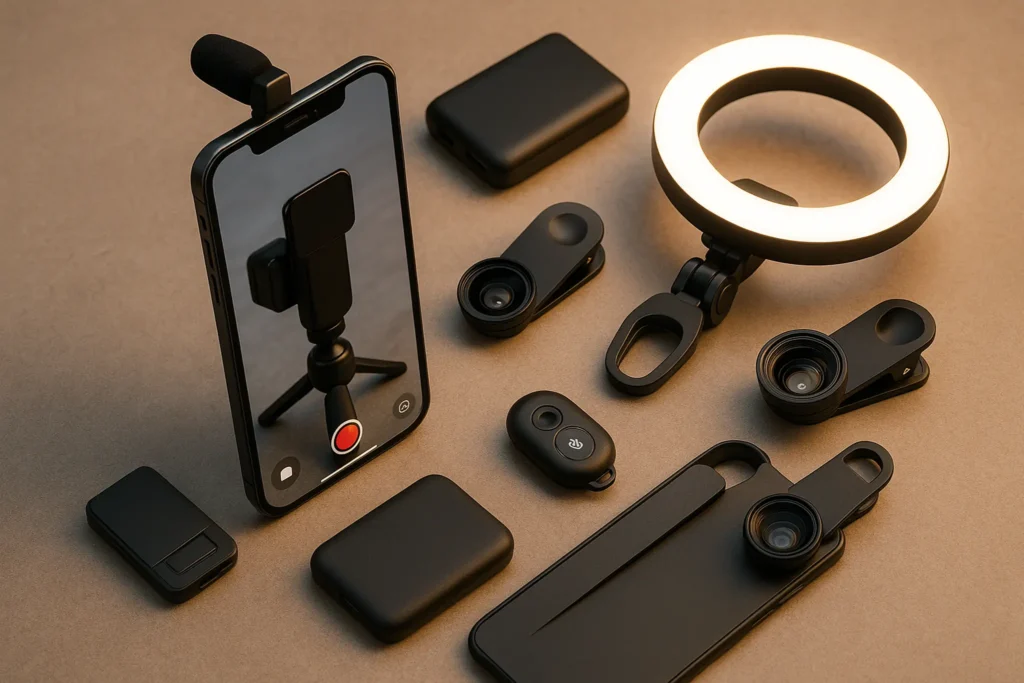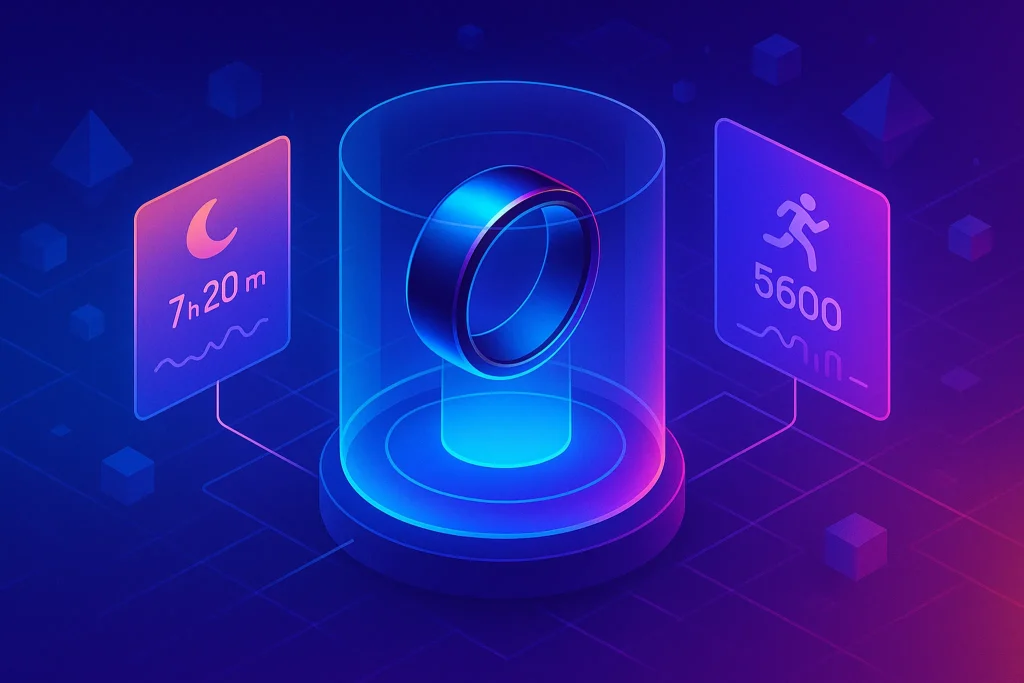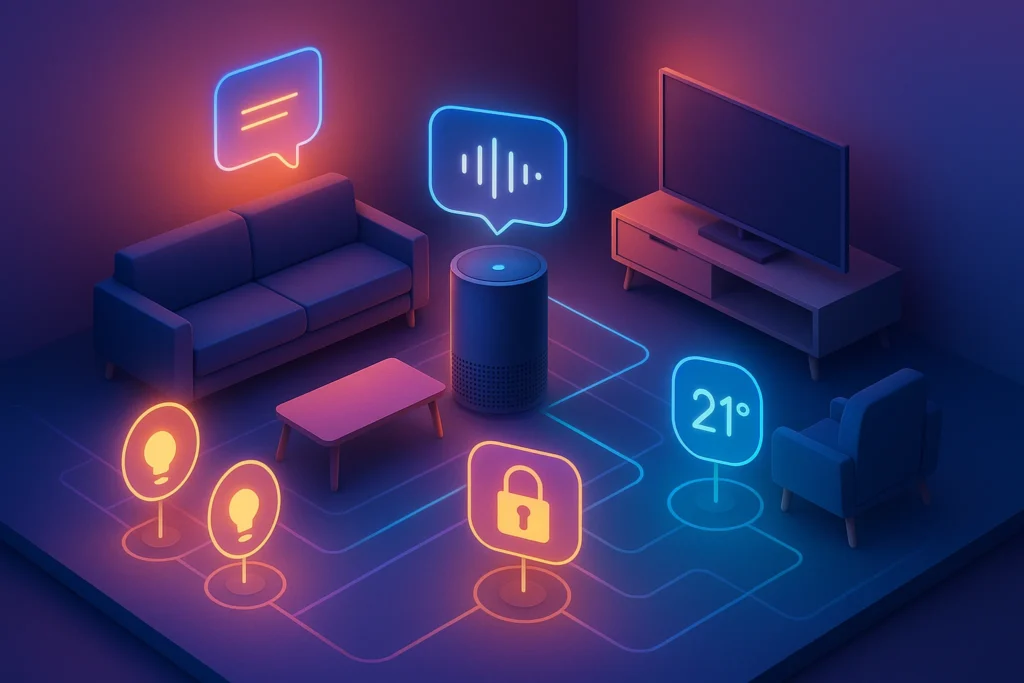-This post may contain affiliate links. If you click on one and make a purchase, I may earn a small commission at no extra cost to you.-
📸 Introduction: Great Content Needs More Than a Good Phone
Smartphone cameras are amazing—but content creation is about more than just pixels.
If you’re a vlogger, TikToker, online educator, or travel creator, you already know: stability, lighting, and clear audio make or break your content. That’s where the right accessories step in.
In this guide, we’ll break down the must-have smartphone tools of 2025 that help creators shoot smarter, faster, and more professionally—without needing a full studio setup.
🎯 Real-World Creator Setups: What Kind of Creator Are You?
Let’s look at how real creators build their mobile gear kits:
🎬 TikToker / Reels Creator
-
Needs: Fast setup, hands-free shooting, consistent lighting
-
Essential Gear: Phone tripod, Bluetooth shutter, LED ring light
-
Workflow: Film + edit in-app → upload directly
-
Add-on Tip: Use a clip-on fill light for better facial definition
📹 Vlogger (YouTube or Personal)
-
Needs: Stability, clean audio, portable gear
-
Essential Gear: Gimbal stabilizer, wireless mic, compact power bank
-
Workflow: Shoot → edit in CapCut or LumaFusion → publish to YouTube
-
Bonus: Add an external storage like iXpand to offload long footage easily
🧳 Travel Blogger / Nomad
-
Needs: Lightweight gear, durability, on-the-go power
-
Essential Gear: Foldable tripod stand, clip-on lenses, rugged SSD
-
Workflow: Capture → quick edit → post while roaming
-
Tip: Pair with Travel Tech for Digital Nomads for full mobile setup
🧑🏫 Educator / Course Creator
-
Needs: Clear audio, lighting, overhead shots
-
Essential Gear: Lavalier or wireless mic, foldable stand, soft LED panel
-
Workflow: Film segments in HD, sync audio, edit in Descript or Canva
-
Tip: Combine with Photography Pro Tips: Using Your Smartphone Camera to Its Full Potential for better video visuals
🎨 Creative Lifestyle Blogger (IG + TikTok)
-
Setup:
Tripod + Ring Light + Lavalier Mic-
iPhone + Tezza app + Snapseed
-
-
Why it works:
Clean aesthetic + polished sound = instantly professional vibe for Reels and brand collabs.
🏞️ Travel Vlogger
-
Setup:
Gimbal + Clip-on Lens (Wide) + Power Bank-
Foldable Phone Stand + LumaFusion
-
-
Why it works:
Lightweight and reliable. Long shooting days + remote editing = perfect mobile kit.
🎓 Educator / Coach
-
-
Setup:
Wireless Mic + Desk Light + Tripod-
Google Drive + Notion + CapCut
-
-
Why it works:
Focuses on audio clarity, steady framing, and fast workflows for creating tutorials or webinars.
-
🧰 Core Accessories That Every Content Creator Should Consider
1. Mini Tripod or Foldable Rig
A mini tripod is a portable, lightweight stand that holds your smartphone steady for hands-free shooting. A foldable rig often includes flexible arms or attachments for mounting lights, mics, or extra phones—turning any surface into a mini production studio.
📌 Why It Matters:
-
It eliminates shaky footage, keeping your content professional-looking.
-
You can shoot from creative angles (top-down, low-angle, over-the-shoulder).
-
It’s especially useful for solo creators and travel vloggers who need stability without carrying bulky gear.
🎯 Use Cases:
A TikToker doing makeup tutorials needs consistent framing at eye level. Using a Joby GripTight tripod or a Ulanzi foldable desk rig, they can position their phone anywhere—from a table to a tree branch while traveling.
-
A TikToker filming a tutorial at a desk
-
A travel creator doing time-lapses from a mountaintop
-
A YouTube educator recording a cooking or drawing tutorial
💡 Nerd Tip: Foldable rigs like the Ulanzi MT-44 can also support ring lights and microphones for a compact full setup.
A stable frame is the foundation of every good shot. Whether you’re recording a sit-down video, an overhead tutorial, or a hands-free TikTok, a mini tripod or smartphone rig is non-negotiable.
✅ Why You Need It:
-
Eliminates shaky footage
-
Enables better angles (low/high, overhead)
-
Essential for long-form and multi-take content
💬 First-Person Insight:
We tested the Ulanzi MT-16 in various travel shoots, and its fold-flat build made it perfect for remote interviews and beach vlogs.
2. Wireless Lavalier Mic or Clip-On Mic
Smartphone mics aren’t designed for clean dialogue. If you’re speaking to the camera, your sound quality matters more than video resolution.
These are small microphones that clip onto your shirt, providing crisp, close-range audio directly from your mouth to the phone—without relying on the weak built-in mic.
📌 Why It Matters:
-
Audio clarity is more important than video quality in most content
-
Wireless options let you move freely during filming
-
They reduce background noise and echo, especially in indoor or echoey spaces
🎯 Use Cases:
-
An online coach recording a face-to-camera explainer
-
A vlogger walking outdoors and talking to the camera
-
A digital nomad creating Instagram Lives in noisy cafes
An online educator recording mini-courses at home clips the mic to their shirt, connects it to their phone, and gets studio-level audio without needing to dub later.
💡 First-Person Insight: We tested the Rode Wireless GO II with both iPhone and Android—it performed incredibly well even in semi-crowded environments, giving polished, podcast-level sound.
🎤 Top Picks:
-
Rode Wireless GO II
-
Boya M1 (budget wired option)
-
DJI Mic (great for creators using both phone + camera)
🎯 Tip: Combine this with iOS Voice Memos or a video editing app with audio sync features for multi-layer recordings.
3. Gimbal Stabilizer vs Tripod – Which One Should You Get? (Mini Comparison)
| Feature | Tripod | Gimbal |
|---|---|---|
| Portability | ✅ High | ⚠️ Moderate |
| Motion Shots | ❌ Static only | ✅ Smooth pans, walking shots |
| Learning Curve | Very low | Requires setup/practice |
| Power Needed | ❌ No | ✅ Rechargeable |
| Best For | Stationary content | Cinematic, movement-based content |
💡 Nerd Verdict:
If you’re mostly filming at a desk or indoors → Tripod
If you’re vlogging while moving, hiking, or storytelling → Gimbal (e.g., DJI Osmo Mobile 6)
4. LED Ring Light / Clip-On Fill Light
Good lighting = fewer edits. A ring light instantly improves clarity, skin tones, and contrast—especially indoors.
Lighting changes everything. These tools provide even, flattering lighting, reduce shadows, and enhance clarity—especially for indoor content or night shots.
📌 Ring Light vs Fill Light:
-
Ring Light: Great for sit-down content like tutorials, interviews, makeup videos
-
Clip-On Fill Light: Best for travel or selfie-style content, attaches directly to your phone
🎯 Use Cases:
-
A makeup creator filming Reels in their bedroom
-
A product reviewer recording unboxings with detail
-
A teacher doing Zoom-based video lessons
A lifestyle blogger filming Instagram Reels at night uses a 12” USB-powered ring light with adjustable color temp to simulate daylight without harsh shadows.
💡 Nerd Tip: Look for models with adjustable color temperature and brightness—this lets you match your lighting to the environment.
💬 First-Person Insight:
We found that for educational content and Zoom calls, a clip-on fill light (like Lume Cube or Godox LED6) gives just the right boost without blinding you.
5. Clip-On Lenses (Macro, Wide, Telephoto)
These expand your phone’s natural camera limitations and are perfect for shooting product photos, close-ups, or vivid landscapes.
Clip-on lenses attach over your smartphone camera and expand your creative range. They simulate the flexibility of DSLR lenses—without needing a separate camera.
📌 Types of Lenses:
-
Macro: Ultra close-up shots (details of a watch, jewelry, textures)
-
Wide-Angle: Expands frame for group shots, cityscapes, room scenes
-
Telephoto: Zooms in without digital distortion
🎯 Use Cases:
-
A tech reviewer shooting close-ups of hardware ports
-
A food blogger capturing wide plates in tight spaces
-
A nature vlogger filming birds without getting close
A tech reviewer shooting product B-roll uses a Moment macro lens to capture port details and build quality—something a regular phone lens can’t nail.
💡 Recommendation: Moment or Apexel Pro lenses deliver DSLR-like sharpness. Avoid cheap plastic ones—they distort the edges.
🏞️ Wide-angle lenses help travel creators shoot buildings, markets, or group scenes.
✅ Tip: Stick to premium options (Moment, Apexel Pro) for clarity. Cheap lenses often add distortion or ghosting.
6. Power Bank for Long Shoots
Content creation drains your battery—especially if you’re filming in 4K or using a gimbal. A high-capacity, fast-charging power bank is crucial.
Video drains your phone battery fast, especially when using 4K, Wi-Fi, or external accessories. A high-capacity power bank ensures you never miss a shot due to low battery.
📌 What to Look For:
-
At least 20,000mAh capacity
-
USB-C Power Delivery for fast charging
-
Multiple output ports (for mic/LED setups)
🎯 Use Cases:
-
A travel vlogger filming all day in remote locations
-
A YouTuber shooting 2–3 long takes per session
-
An event blogger covering live moments without pause
💡 Tested Pick: Anker PowerCore PD 26800 lasted through 6 hours of shooting with a mic and light connected. A game-changer for mobile creators.
🔋 Nerd Tip:
Go for 20,000mAh+ with USB-C PD (Power Delivery).
Try: Anker PowerCore PD 26800 or Zendure SuperMini X3.
📍 Best for:
-
Travel creators shooting full days
-
Educators recording long screencasts
-
TikTokers doing multiple takes
7. External Storage: OTG SSD or iXpand Flash Drives
Running out of phone space mid-recording is a creator’s nightmare. External drives plug directly into your smartphone, allowing you to offload and store videos quickly—without needing a laptop.
📌 Best Choices:
-
iXpand: Made for iPhones, supports direct file backup
-
Samsung T7 SSD with OTG adapter: Works flawlessly on Android and iPad
🎯 Use Cases:
-
A documentary vlogger capturing hours of footage on the road
-
A TikTok creator batch-recording 20 videos in a single session
-
A mobile photographer shooting RAW images daily
💡 Tip: Store files by content type (Reels, YouTube, courses) so you can access them fast for editing or backup.
💽 Example:
-
SanDisk iXpand (for iOS)
-
Samsung T7 SSD with USB-C OTG (for Android)
🎬 Nerd Tip: Offload RAW footage here and edit later on laptop or tablet.
8. Bluetooth Remote Shutter
This tiny device lets you start/stop recording or take photos remotely—no more rushing back to your phone or accidentally shaking the shot.
📌 Why It Matters:
-
Solo creators can record cleanly without editing out awkward arm movements
-
Perfect for group shots, hands-free talking heads, or recording from across a room
🎯 Use Cases:
-
A lifestyle creator shooting reels from different distances
-
A yoga instructor recording full sessions without touching the phone
-
A digital nomad capturing street photography or time-lapses unnoticed
💡 Real Use: Combine this with your tripod and a clip-on light—you’ve got a studio in your backpack.
🎮 Tiny but powerful, a Bluetooth shutter lets you:
-
Record without touching your phone
-
Capture multiple takes easily
-
Avoid awkward pauses or trimming
💡 Great for:
-
One-person setups
-
Reels / TikTok skits
-
Dance or motion-heavy videos
🎁 Bonus: Surprisingly Useful Accessories You Didn’t Know You Needed
Sometimes it’s the smallest gadgets that make the biggest impact. Here are underrated tools that creators swear by:
📐 Foldable Phone Stand
Perfect for desktop creators, this lets you adjust angles effortlessly during tutorials or livestreams.
✅ Doubles as a travel stand for planes or cafes.
🌬️ Mini Desktop Fan
Shooting under lights gets hot fast—especially for beauty or tutorial creators. A silent mini fan keeps you cool without ruining audio.
🧼 Lens Cleaning Pen or Wipes
Smudged lenses = soft, hazy footage. A $5 cleaning kit literally upgrades your footage clarity instantly.
🎧 In-Ear Monitor (IEM) or Wired Headphones
Use it to monitor audio live while recording or during editing. Especially helpful for podcasts and voiceovers.
🧰 Recommended Starter Kits by Budget
| Budget | Gear Combo | Notes |
|---|---|---|
| 💸 Under $50 | Tripod + Wired Mic + Basic Light | Great for beginners, surprisingly solid results |
| 💵 $100–150 | Tripod + Wireless Mic + Ring Light | Balanced setup for Reels & TikTok |
| 💰 $300+ | Gimbal + Wireless Mic + Premium Lenses | For serious creators or semi-pro vloggers |
Tip: Always invest in audio first—bad video can be forgiven, but bad audio can’t.
🧪 Content Workflow: Record – Backup – Publish
Here’s how smart creators stay organized and avoid losing content:
-
Plan scenes (in Notion or Trello)
-
Record with gear setup
-
Immediately backup to SSD or cloud
-
Edit in CapCut / InShot / LumaFusion
-
Publish + schedule via Buffer or Later
🔁 Bonus: Link your accessories into workflows—e.g., Bluetooth shutter + phone clip = fast multi-take sessions.
🚫 Common Mistakes to Avoid
-
Relying only on phone mic
→ Fix: Get even a basic clip-on mic. -
Overcomplicating your setup
→ Fix: One light + one tripod + clean audio = enough for 90% of creators. -
Cheap clip-on lenses
→ Fix: Avoid distortions with trusted brands. -
Ignoring lighting
→ Fix: Even a $20 fill light changes the game.
🧠 Nerd Verdict: Build Your Creator Setup Like a Pro
Here’s the truth: you don’t need everything at once. But building a smart, modular kit based on your content style will massively improve your production quality.
Whether you’re filming vertical short-form videos or teaching full-length tutorials, the gear listed above empowers you to create confidently with your phone.
👉 My personal recommendation?
Start with three things:
-
A stable tripod
-
A proper mic
-
A light source
Then grow from there as your workflow evolves.
And remember—good gear doesn’t replace good storytelling. Use these tools to enhance, not distract from, your message.
❓ FAQ: Nerds Ask, We Answer
Q: Do I need a gimbal if I already have a tripod?
Not necessarily. A tripod is great for static shots. If you plan to shoot while walking, tracking, or doing cinematic movements, a gimbal is worth it.
Q: Are cheap clip-on lenses useful?
Budget lenses can work for fun or casual use. But if you’re serious about quality, invest in trusted brands like Moment or Apexel Pro.
Q: What power bank should I get for long shoots?
Look for 20,000mAh or more, with USB-C PD output. Avoid anything below 10,000mAh for video creators.
Q: Is external storage really needed in 2025?
Absolutely, especially if you shoot in 4K or RAW. Phone storage fills up fast—external SSDs are a lifesaver during travel or batch shoots.
💬 Would You Bite?
What’s the one mobile accessory that leveled up your content creation the most?
Drop your go-to gear setup below—or share a tool you discovered recently that changed your creative workflow! 🎥👇Let’s help each other build smarter creator kits 💡



